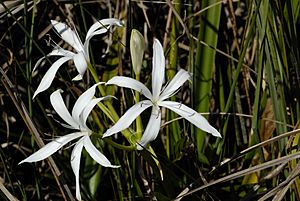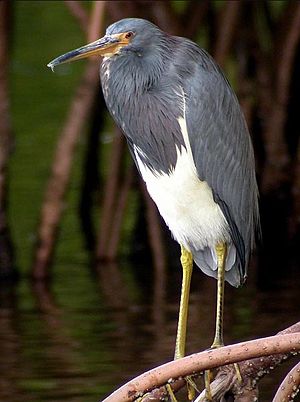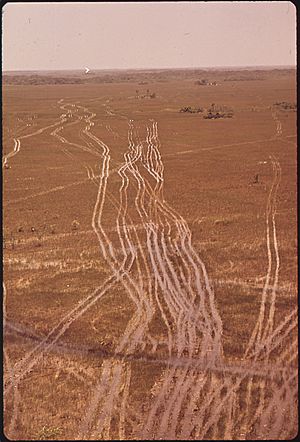Florida swamps facts for kids



Florida swamps are special kinds of wetland areas. They are like watery forests or grassy lands that are often covered in water. Florida has many swamps because it gets a lot of rain, its ground is very flat, and the water table (the level of water under the ground) is high. This makes it easy for water to collect and create these unique habitats.
Contents
Types of Florida Swamps
Florida is home to several different types of swamps. Each type has its own special plants and animals.
Here are some common swamp types you can find in Florida:
- Cypress dome: This is the most common type of swamp in Florida. It looks like a dome from above because the cypress trees in the middle grow taller than those on the edges.
- Strand swamp: These are long, narrow swamps that often follow slow-moving rivers or streams.
- Floodplain swamp: These swamps are found along rivers and get flooded when the river overflows its banks.
- Titi swamp: Named after the "titi" shrub, these swamps are often found in sandy areas.
- Tupelo gum swamp: These swamps are dominated by tupelo gum trees, which love wet conditions.
- Mangrove swamp: Found along Florida's coasts, these swamps are filled with special trees called mangroves that can grow in salty water.
Famous Swamps to Explore
Florida has many well-known swamps that are important for nature and wildlife.
Some of the most famous swamps include:
- Green Swamp (Florida): This large area in Polk County helps supply water to many of Florida's rivers.
- Everglades: A huge wetland area in southern Florida, famous for its unique ecosystem and wildlife.
- Corkscrew Swamp Sanctuary: Located in southwest Florida, this sanctuary protects one of the largest remaining old-growth bald cypress forests.
- Okefenokee Swamp: This large swamp crosses the border between Florida and Georgia.
- Barley Barber Swamp: A smaller, but important, swamp known for its beautiful cypress trees.
- Santa Fe Swamp: Found in northern Florida, this swamp is part of the Santa Fe River basin.
Amazing Animals of the Swamps
Florida swamps are home to many incredible animals, including some that are rare or endangered.
Here are a couple of special swamp residents:
- Florida panther: This is a very rare type of cougar. It is an endangered animal, meaning there are not many left in the wild. Swamps provide important habitat for these big cats.
- American alligator: These large reptiles are a common sight in Florida's swamps. They are important predators that help keep the swamp ecosystem healthy.
Unique Plants of the Swamps
The plants in Florida's swamps are specially adapted to live in wet conditions.
Some of the plants you might see include:
- Cypress trees:
- Bald cypress: These tall trees can live for hundreds of years and are known for their "knees" that stick out of the water.
- Pond cypress: A smaller type of cypress tree often found in pond-like swamps.
- Red mangrove: These trees have special roots that grow out of the water, helping them breathe and providing shelter for young fish.
- Palms:
- Cabbage palm: Florida's state tree, often found in swamps and other wet areas.
- Florida royal palm: A very tall and majestic palm tree.
- Sawgrass: This sharp-edged grass covers vast areas of the Everglades.
- Spanish moss: This air plant hangs from tree branches, giving the swamps a mysterious look.
Fun Facts About Florida Swamps
Swamps are not just natural places; they also inspire names and stories!
- The football stadium at the University of Florida is famously called "The Swamp." This nickname comes from the fact that the university's sports teams are called the Florida Gators, and alligators live in swamps.
- In Gainesville, where the University of Florida is located, there's even a place called Swamp Head Brewery.
- There's a band called Swamp Cabbage that plays "swamp blues" music. The band was started by a guitarist from Jacksonville.
See also
 In Spanish: Pantanos de la Florida para niños
In Spanish: Pantanos de la Florida para niños


